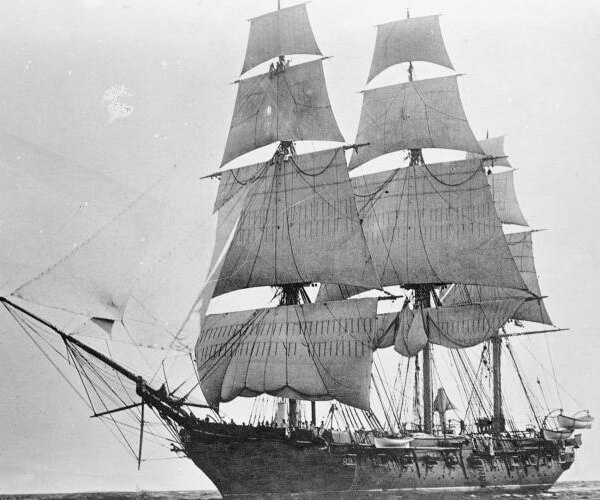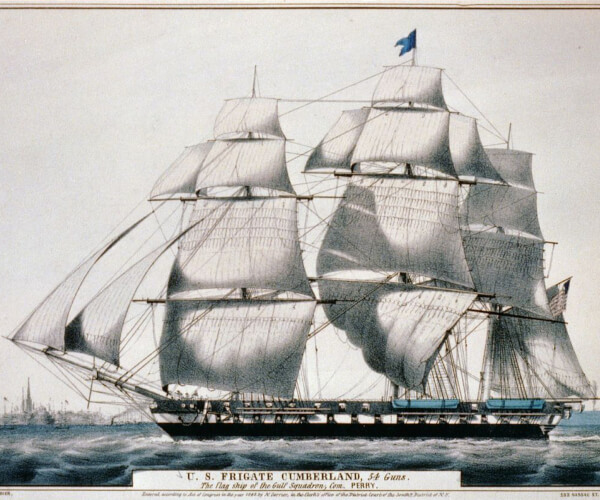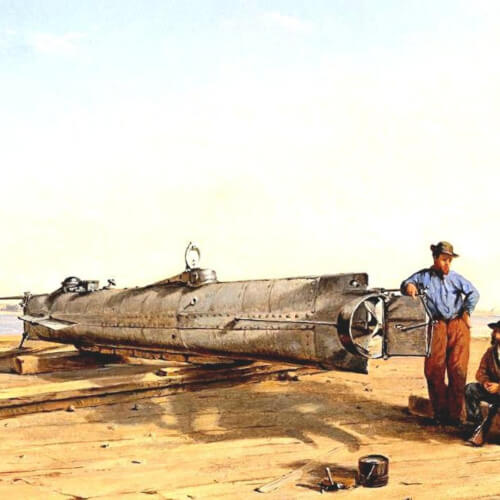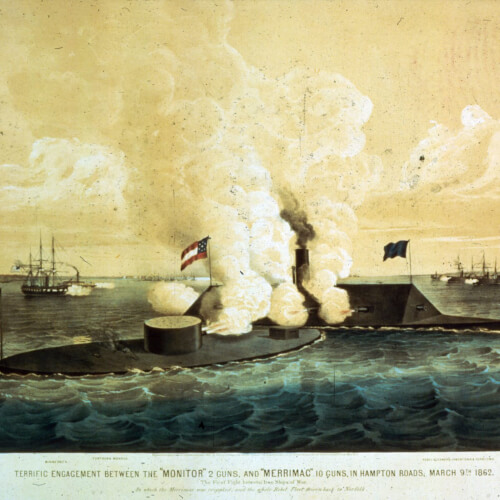Civil War Arms and Equipment
Exploring the weapons and technology of the Civil WarCivil War Navy
The war at sea would play a major part in winning the Civil War. While many were focusing on improving how fighting took place on the ground, others began to realize that naval warfare would play a large role in victory. Foremost, the North needed a way to intercept ships bringing overseas goods to the Confederacy. Despite numerous improvements in ground transportation, especially railroads, the majority of men and supplies would be transported on water. Whichever side could control America’s waterways, could win the war. This naval war was directed by two men: Gideon Welles, the 24th U.S. Secretary of the Navy, and Stephen Mallory, the Confederate States of America’s Secretary of the Navy. Advancements in naval warfare occurred quickly throughout the war thanks to new technology. Many ships were refitted with guns and cannon or were plated with armor. Ironclad ships struck fear on the water and were effective against traditional ships but often sank due to accidents or bad weather. The Civil War also saw the use of the submarine as a new weapon on the water.
Sloops of War
During the Civil War, a sloop of war was a small sailing warship that had a single gun deck that carried from 10 to 18 guns. These ships typically had three masts and were driven by wind power and had no protection other than a wood hull. Screw sloops were fast and lightly armed steamships that used propellers to move through the water.
The USS Kearsarge was a good example of a sloop of war. It was built at the Portsmouth Navy Yard in Kittery, Maine and launched in 1851. The USS Kearsarge is famous for hunting Confederate ships including her defeat of the Confederate commerce raider CSS Alabama at the Battle of Cherbourg on June 19, 1864.
Steam Frigates
At the start of the Civil War, the US Navy had no ironclad ships. Their most powerful ships were the steam-powered frigates. These warships were propelled by a combination of square-rigged sails and steam. They were also the first US ships to be driven by a propeller on a shaft that projected through the stern of the ship known as a screw. These ships ranged in length from 256 feet to 265 feet. The ships were equipped with 26 Dahlgren smoothbore canons on the main deck and 8-inch shell guns in broadside and a 10-inch gun that was typically mounted forward on the spar deck.
Submarines
During the Civil War, the Confederacy emerged at the forefront of submarine warfare. While not a new invention, the Confederates improved on previous designs for a fully submersed vessel that could attack Union ships. In 1862, the Confederates launched a boat called the David. This boat was not a true submarine because parts needed to be above water to provide air for the crew and steam-powered engine. The first true submarine was the Confederate CSS H.L. Hunley. It was made from a steam boiler forty feet long and less than four feet in diameter. An eight-man crew turned a hand-cranked propeller and similar to the David, the Hunley had a spar torpedo. This weapon was a long pole that held an explosive charge at the end and was designed to explode when it was rammed into an enemy vessel. The Hunley became the first submarine to destroy an enemy ship when it sunk the Union USS Housatonic near Charleston, SC on February 17, 1864. Unfortunately, the sub never made it and sank after the attack with all crew members trapped on board.
The Ironclads
From the outset of the Civil War, the Union and Confederate navies rushed to build ironclad ships in an effort to control the seas. Due to improvements in the creation of steel plates, warships on both sides would be able to easily attack and defeat their wooden counterparts. The USS Monitor, with it’s unique rotating gun turret, would become the Union’s first ironclad while the first Confederate ironclad was called the CSS Virginia. The Virginia was a retrofitted Union ship that was covered with four-inch thick steel plates. Ironclads first saw action in 1862 at the Battle of Hampton Roads. On March 9, 1862, the day after the Virginia sank two Union ships, the ironclads met in battle for the first time at Hampton Roads, Virginia.The two fought to a draw, bouncing hundreds of shots off each other’s armor over an hours-long battle.
Learn More
Torpedoes
In the South, where iron was scarce and the ability to make powerful steam engines was virtually nonexistent, Confederates were also forced to seek other methods of protecting their ports from an increasingly armored Union fleet. One solution was to deploy “torpedoes” – submerged explosives (which would be called sea mines today) that could detonate under enemy ships. Torpedoes therefore had the advantage of being able to attack an ironclad below the waterline, where its hull was most vulnerable.
When torpedoes proved successful, the Confederacy designed the first “torpedo boats,” which carried mines on long spars in front of the ship. The boats sat low in the water so that they were harder to see, and presented a smaller target to cannon fire. On multiple occasions, torpedo boats (which were quickly adopted by the Union) were able to sail up to anchored ships and detonate torpedoes against the vessels’ hulls.
Serving in the Navy
The Union Navy grew rapidly during the Civil War. Over the course of the war, the navy expanded from about 9,000 officers and men in 1861 to over 118,000 by 1865. Most new sailors in the Union Navy had no experience at sea. Ship crews included farmers, tradesmen, factory workers, immigrants, and African Americans. Some joined to avoid being drafted into the army, where the chance of being killed or wounded was much higher. Only about 4,000 Union sailors died during the war. When not called on to do battle, sailors scrubbed decks, shoveled coal for steam boilers, tended sails, and conducted drills.
Anaconda Plan
The Anaconda Plan was a tactical plan for the Union whose main purpose was to cutoff the South from the rest of the world, and even themselves. The plan consisted of three major parts. First, was to blockade all of their ports so they wouldn’t receive any supplies from foreign countries. This also served another purpose since the Confederacy had a 3,500 mile long shore where the Union could easily attack from behind or take coastal cities by surprise. It was made worst due to the fact that the Confederacy didn’t have enough men to fight in the front-lines and defend the shore from invasion.
Even though the Union blockaded most of the Confederacy’s large ports they couldn’t stop all of the South’s commerce. Fast Merchant steamers, called ” blockade runners” could usually evade the Northerner’s blockade, but this dwindled as newer and faster ships arrived to the blockade that could stop the blockade runners.
The Confederate Navy
In February 1861, the Confederate Congress created a Department of the Navy and Confederate President Jefferson Davis selected Stephen Mallory from Florida to lead the department. Prior to the outbreak of the war, Mallory was a member of the US Senate Naval Affairs Committee. At the outset, the Confederate Navy consisted of about a dozen ships from South Carolina, Florida, Louisiana, Texas, Alabama, Virginia, and North Carolina. By 1865, the Confederate Navy was able to put 130 ships on the water compared to about 675 from the Union Navy. The goal of the Navy was to protect the southern coastline, break the Union blockade, and to raid enemy ships. While the Confederate Navy was moderately successful at commerce raiding, it never provided an adequate coastal defense or broke the Union blockade. Unfortunately, the lack of funding and overall support from the government did hamper the overall effectiveness of the Navy.
Learn More
Videos
Vocabulary
Blockade – a war measure isolating an area of importance to the enemy
Ironclad: A ship protected by iron armor.
Torpedoes: . They floated below the surface of the water and exploded when the hull of a ship brushed against them.




